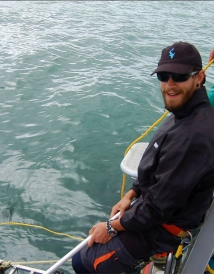Simone Rizzuto
PhD student - Stellenbosch University
Simone is a PhD student - Stellenbosch University. “I have always been fascinated by the marine environment and its inhabitants, especially large predators such as sharks and cetaceans (dolphins). For this reason I decided to use this love for sea to make a career of it. Moreover, I really wanted to find out how I could be useful in safeguarding the marine environment against all anthropogenic actions that sadly cause great environmental disasters. That’s why I chose to get a degree in Marine Biology.”
Simone completed his BSc in Biological Sciences in 2010 the continued with his Masters in Monitoring and Conservation of Marine Environment in 2012, at the Italian University of Siena. An encounter with an Italian researcher (Dr. Primo Micarelli) brought him to South Africa, where he started working since 2011 on white shark (Carcharodon carcharias) conservation as a member of the Italian Research group Centro Studi Squali, allowing him to conduct the first study on the ecotoxicology of white sharks, supported by Dr. Letizia Marsili from University of Siena. In 2014 the University of Stellenbosch offered Simone a PhD position in South Africa, allowing him to continue studying white sharks, but it’s only the generous help and collaboration of all the people and staff of the Ecotourism Operator Marine Dynamics and Dyer Island Conservation Trust that let him to do all the fieldwork in Kleinbaai, collecting biopsies of white sharks. “I must say that I have never found a Company like this: all the people from the owner Wilfred Chivell, passing to the crew and the staff are strongly committed to research, and everything I need for my work here is immediately provided. It’s like being in a big family where everyone works with the precise objective to fulfil the needs of researchers and obviously clients. For the first time ever I am allowed to collect tissue samples from a touristic platform (the Slashfin boat) with clients on board. It’s a wonderful experience that everyone can benefit from, with particular regard to the clients that are allowed to see how biologists work and be part of white shark Conservation. The aim of my PhD research is to assess the presence of persistent organic pollutants (POPs) and their effects on white shark reproductive health, using non-lethal techniques to get samples such as tissue biopsies.” Simone is proposing to determine real contamination levels in a white shark population, including different ages and sexes as a baseline situation analysis. “Studying apex predators such as white shark is a big issue: very few people are aware about what kind of problems could be caused If those animals go extinct. Marine environmental balance is very delicate: If we keep on perpetuating harmful actions (as the continue input of anthropogenic contaminants) we can influence this balance in such a way from where will be difficult to return back. A particular aim of this research is also to increase people knowledge and awareness about how many contaminants they can absorb eating sharks’ meat.”


